
 |
| Above: Home to some 300,000 date palms and one-tenth as many people, Siwa lies 300 kilometers (185 mi) from Mersa Matruh, the nearest town. A road first connected the two in the mid-1980’s. Heavy rains “melted” the old town, foreground, in 1926. Right: As head of local education, |
 |
| Baghi deploys Siwi, Arabic and English with equal ease. “Among ourselves, we always speak Siwi. But to deal with the outside, we need Arabic,” he says. |
Written by Sylvia Smith
Photographed by Laura
El-Tantawy
 he light cast by the rising moon glinted and danced on the glassy surface of a vast salt lake as we drove back toward the oasis. Before sunset, we had seen luminous rocks, shell beds and miles of dunes all around, the start of the Great Sand Sea that runs east to the Nile and stretches endlessly west across North Africa toward the Atlantic. Abdallah Baghi had stopped to let some air out of the tires, the better to ride over the soft sand. He explained that he was navigating in part by eye, looking out the Jeep’s side window to spot the different types of sand and avoid getting stuck.
he light cast by the rising moon glinted and danced on the glassy surface of a vast salt lake as we drove back toward the oasis. Before sunset, we had seen luminous rocks, shell beds and miles of dunes all around, the start of the Great Sand Sea that runs east to the Nile and stretches endlessly west across North Africa toward the Atlantic. Abdallah Baghi had stopped to let some air out of the tires, the better to ride over the soft sand. He explained that he was navigating in part by eye, looking out the Jeep’s side window to spot the different types of sand and avoid getting stuck.
Darkness brought with it the profound sense of isolation in the desert that Paul Bowles called “the baptism of solitude.” Then suddenly Baghi’s cell phone rang. The 21st century reasserted itself, and I returned to being a mere passenger in a Jeep. Speaking in his native Siwi—a Berber dialect—Baghi continued driving in the dark with the assurance of a man who knows the landscape by heart. Then he held the phone away from his ear so I could hear a loud bellowing. “Donkey!” he said, smiling widely.
The braying of donkeys is one of the signature sounds of the swath of green that is the oasis of Siwa. “You can’t get away from donkeys here,” he laughed. “They are part of our lives.” As if on cue, a small boy went pastus in the other direction, confidently driving one of the donkey carts thatin Siwa are still more common than motorized transport.
“See what I mean?” Baghi pointed out. “Boys learn to manage a donkey cart almost as soon as they can walk. It’s part of what we learn from our fathers.”
But it’s not all that Siwan children learn: As head of Siwa’s Education Department since 1999, Baghi administers the school curriculum under the auspices of the Egyptian government.
 |
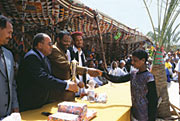 |
RICHARD DUEBEL
Uncontrolled private well-digging has caused overfilling of the salt lakes that lie on the edge of the oasis, threatening some date groves. Bottom: The captain of Siwa’s championship soccer team receives a trophy and a handshake.
|
More importantly, he is a leader to whom people in the oasis voice their concerns about matters from tourism to land sales and from organic produce to cultural preservation—all issues that arise as Baghi helps to steer Siwa through the rapidly shifting sands of modernity.
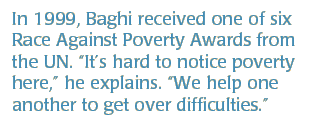
Salamah, a farmer who comes to town once a week to sell his produce at market, tells me that the oasis, whose population now stands at about 30,000, runs on cooperative, close-knit connections among its people. His business is doing well, he says, but he is concerned about the impact of “outside influences” that have come since the 1980’s, when an asphalt road was built that links Siwa to the city of Mersa Matruh on the Mediterranean coast.
“We now have lots of people coming here, buying land,” he confides. “Some of them are Egyptian; some are foreigners. They say they want to build houses or hotels, or else use the land for agriculture. We want to share our oasis, but we don’t want it spoiled. Already a couple of my neighbors have sold off some of their plots for small amounts of money. That’s a short-term view. They can’t see what this will mean if lots of us all do the same.”
Baghi is well aware that part of Siwa’s allure is that everything grown in the oasis is naturally organic. “No pesticides have ever been used here,” he explains. “Business people from Cairo and Europe see the potentialfor growing organic produce. It’s still easy to buy land cheaply. There areno official statistics about how much land has been sold off. But I worry that local people may lose out.”
In 1989, Baghi helped organize the Siwa Heritage Committee to protect costumes, silver jewelry, basketry and other craftwork and antiques that were rapidly being bought up by tourists and collectors from Siwan families eagerfor cash to buy new consumer goods. The committee’s museum, Siwa House, is now “part of a network of small museums all over Egypt. We’re learning how to conserve our past, and that’s important. Only now, it is the land itself that we’re losing,” Baghi concedes. “It’s not happening in a way we can easily control: just individuals coming to buy without making a fuss.”
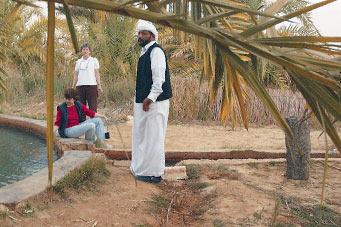 |
| One of the oasis springs helps irrigate a date grove. |
Baghi’s profile in Siwa received a boost in 1999 when he was one ofsix people worldwide who received that year’s United Nations Race Against Poverty Award, given annually toleaders in remote areas who help better their communities.“
It’s hard to notice poverty here,”he explains. “Siwans have their dignity. There are no beggars in the street,and we help one another to get over difficulties.” Ali, a small, wiry man who works as a waiter, explains that Baghi’s great-great-grandfather wrote Siwa’s constitution. “He was a strong man who brought prosperity to many people in the oasis,” he says.
Having its own constitution underlines the historical independence of the oasis, one of the most remotein the vast Sahara region. “It doesn’t mean we don’t follow Egyptian law,”Ali adds. “These are additional rules that govern our conduct toward one another. Siwa is a very close-knit place: No Siwans ever leave permanently. If they leave to study, they always come back.”
Baghi’s tall, well-built frame is almost as universally known in the oasis as his elderly, somewhat battered Jeep. People wave to him, and they come forward to greet him as he gets out of the car. “Among ourselves, we always speak Siwi. But to deal with the outside, we need Arabic. So the children in school study Arabic. Many older people don’t know Arabic. But now we are part of the modern world,” he says.
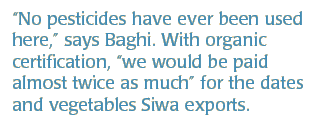 Another reason he is highly regarded is his degree in philosophy from Alexandria University and his polished, idiomatic command of English. Even though he does not hold thetitle of shaykh, nor sit on the town council (which reaches its decisionsby majority vote), he is uniquely influential in connecting the oasis to the larger world.“
Another reason he is highly regarded is his degree in philosophy from Alexandria University and his polished, idiomatic command of English. Even though he does not hold thetitle of shaykh, nor sit on the town council (which reaches its decisionsby majority vote), he is uniquely influential in connecting the oasis to the larger world.“
He is always well informed,” remarks Salamah. “Most of us only hear rumors, but Abdallah gets to the heart of what’s really going on.” Salamah tells how, despite the hundreds of natural springs that have irrigated Siwan agriculture for centuries, some years ago farmers came to believe that individual water supplies could raise the productivity of their lemon, mulberry, almond, carob, peach and olive trees. The wells they dug gushed uncontrolled, and the excess water flowed to the lowest points in the oasis—the salt lakes that surround Siwa.“
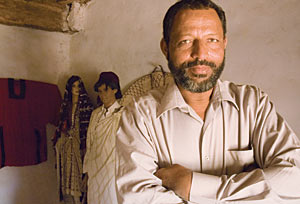 |
| The Siwa Heritage Committee, which Baghi helped organize, runs the town’s small museum. “We’re learning how to conserve our past,” he says. |
And so, as the level of the lakes rose, the salty water started to nibble at the edges of the date groves,” Salamah goes on. Baghi interrupts to point to a couple of shut-off taps in neighboring gardens. “New drilling is now banned, and all small, individual springs have been capped. We’ve set up times for each garden to use the water from the main springs. We’re waiting to see if that solves some of the problem.”
The alarm about the lakes comes from their potential threat to the basis of the Siwan economy: the harvest from some 300,000 date palms.There is no overall figure for thevalue of the crop, but there are five date-packaging plants in the oasis employing hundreds of people.“
This is why getting organic certification is a priority for us,” Baghi says, adding that Siwan farmers are already in contact with the main European certification agencies for both dates and Siwa’s number-two crop, olives. “We would be paid almost twice as much for the same amounts of fruit. But farmers are still poor. They’re easily persuaded to sell off parcels of land to foreigners, and we don’t yet know what will happen in the long term,” he says.
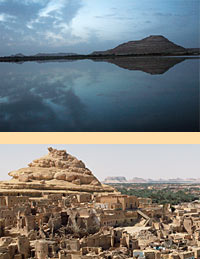 |
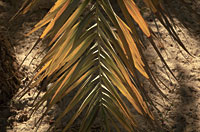 |
| From top: Salt lakes around the oasis; the old city of salt and mud, now popular with tourists; a frond of the date palms that sustain Siwa’s economy. |
Farther down the road is a piece of land that will never be up for sale, nor will it be built upon. It’s the Shali, the old walled town that a three-day rain in 1926 literally melted into haunting, Gaudi-esque ruins.
As Baghi strides along pointing to landmarks, a stooped, elderly man named Sulayman greets him. In his younger days, Sulayman was the muezzin who called worshipers to prayer five times a day. “You see the old adobe mosque over there,” Baghi points out. “We are hoping that more of the new houses being built in the oasis will have a final coat of our traditional salt mud. That’s one of the characteristicsof our architecture.” Sulayman nods in agreement. “Using concrete may be practical, but it doesn’t look right here,” he says.
Baghi’s view is that adobe is the appropriate type of construction in Siwa, even though “it is pricey to build and maintain these traditional houses,” he admits. “But by putting a final coat of mud on houses built of modern materials, we can keep costs down, and yet buildings look traditional. It’s also a matter of passing on skills. We’re already training youngsters in the mud technique.”
According to Mounir Neamatallah, Egypt’s lead-ing environmentalist whoin 1997 built an adobe ecolodge called the Adrere Amellal (“White Mountain”), Baghi “knows how much of the modern world Siwa can accommodate without losing its traditions. Abdallah can talk to the community informally and let them see the bigger picture. He understands that things are going to change, but with his help, Siwa can manage the transition.”
 |
Sylvia Smith is a BBC reporter who specializes in North African and Middle Eastern cultural affairs. |
 |
Laura El-Tantawy (ltjournalist@yahoo.com) is a free-lance photojournalist based in Cairo and a contributor to Corbis Images.
|